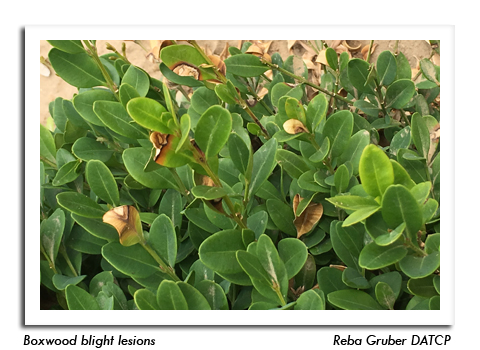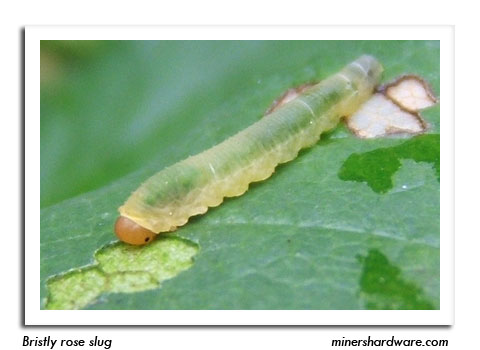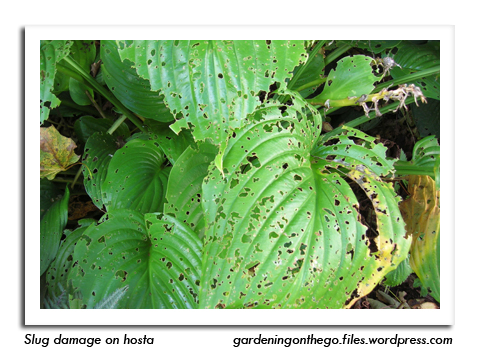
 |
|
|
Nursery & Forest
Volume 64 Number 8 Date 06/20/2019 BOXWOOD BLIGHT - 'Green Velvet' boxwood stock from an Oregon supplier was found positive for boxwood blight at a Michigan box store chain last week, and DATCP inspectors are currently checking for diseased plants that may have been shipped to Wisconsin retailers. Boxwood blight is a developing problem, with infected plants occurring at numerous locations nationwide, from numerous sources. Retailers and homeowners are encouraged to check their boxwood plants for symptoms, and symptomatic plants should be sampled and tested at the UW Plant Disease Diagnostic Lab. More information about boxwood blight, its symptoms, and testing can be found at https://datcp.wi.gov/Pages/Programs_Services/BoxwoodBlight.aspx. EUONYMUS CATERPILLAR - A heavy infestation of this insect was observed on Euonymus spindletree shrubs at a nursery in St. Croix County. The cream-colored larvae with black heads and a black lateral spot were near maturity. Chemical control is no longer advised in locations where larvae have reached the later instars and are likely to pupate soon. Plants can usually tolerate defoliation for one year, but multiple years can lead to decline. Smaller infestations may be successfully treated by hand pruning to remove the infested foliage. ROSE SLUG - The tiny green larvae of this sawfly were feeding on rose foliage in La Crosse County this week, and skeletonizing the leaves. Severe defoliation may be avoided by removing the larvae and damaged, lacy leaves. Horticultural oils or residual insecticides are also effective. JUMPING WORMS - Invasive "jumping worms" were recently confirmed in Sauk County. This damaging Asian pest, named for its unusual thrashing behavior when disturbed, was first detected in the state in 2013. The term 'jumping worms' refers to multiple species, all in the genus Amynthas. The 1.5 to 8-inch long worms can be identified by the smooth, whitish non-segmented band around the body (clitellum). Other common worm species have a raised band. Jumping worms reproduce asexually and infest soil in high densities, altering soil texture and composition. Their feeding strips nutrients, kills plants, and increases erosion. A single worm can start a new population. Human-assisted dispersal by moving potted plants, soil, compost, mulch and fishing bait is a leading contributor to the spread of jumping worms. Actions recommended to reduce their spread include cleaning soil and debris from vehicles, equipment, gardening tools, and shoes before moving to and from a work site or recreational area. Gardeners and property owners who suspect they have jumping worms should keep any potentially infested plant, soil and mulch on site. These materials should not be sold, transplanted, or shared. More information can be found on the DNR website at https://dnr.wi.gov/topic/Invasives/fact/jumpingworm/index.html. Sightings of jumping worms can be reported to the Wisconsin DNR by emailing invasive.species@wi.gov or uploading a photo to the First Detector's Network, https://fyi.extension.wisc.edu/wifdn/get-involved/report-invasive-species/. SLUGS - Persistent wet conditions are providing favorable conditions for slug activity and damage in some areas of the state. Because slugs are nocturnal feeders, plant damage appears overnight and the cause is usually not apparent. Species such as the grey field slug, Deroceras reticulatum, are capable of inflicting substantial crop and garden damage, traveling up to 40 feet in one night. Slug activity quickly subsides with drier weather, but if control is warranted, a few options are as follows: sprinkling diatomaceous earth atop the soil beneath high-risk plants; encircling containers and small raised beds with protective copper tape; or trapping slugs by placing wet newspapers beneath boards laid on the ground. Slug baits with an iron phosphate component are often a good solution in mulched perennial beds. -- Tim Boyle and Konnie Jerabek, DATCP Nursery Inspectors 




|
|
|